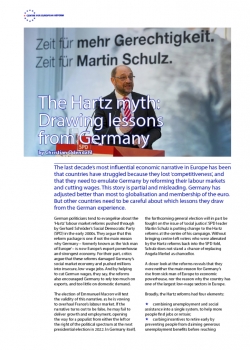
The Hartz myth: Drawing lessons from Germany
Germany's Hartz labour market reforms were no miracle cure. Rather than copying them, the rest of Europe should learn more nuanced lessons from the German experience.
The last decade’s most influential economic narrative in Europe has been that countries have struggled because they lost ‘competitiveness’, and that they need to emulate Germany by reforming their labour markets and cutting wages. This story is partial and misleading. Germany has adjusted better than most to globalisation and membership of the euro. But other countries need to be careful about which lessons they draw from the German experience.
German politicians tend to evangelise about the ‘Hartz’ labour market reforms pushed through by Gerhard Schröder’s Social Democratic Party (SPD) in the early 2000s. They argue that this reform package is one if not the main reason why Germany – formerly known as the ‘sick man of Europe’ – is now Europe’s export powerhouse and strongest economy. For their part, critics argue that these reforms damaged Germany’s social market economy and pushed millions into insecure, low wage jobs. And by helping to cut German wages, they say, the reforms also encouraged Germany to rely too much on exports, and too little on domestic demand.
#Germany has one of the largest low wage sectors in Europe, #labourmarket reforms are not the reason.
The election of Emmanuel Macron will test the validity of this narrative, as he is vowing to overhaul France’s labour market. If the narrative turns out to be false, he may fail to deliver growth and employment, opening the way for a populist from either the left or the right of the political spectrum at the next presidential election in 2022. In Germany itself, the forthcoming general election will in part be fought on the issue of ‘social justice’. SPD leader Martin Schulz is putting change to the Hartz reforms at the centre of his campaign. Without bringing centre-left voters who were alienated by the Hartz reforms back into the SPD fold, Schulz does not stand a chance of replacing Angela Merkel as chancellor.
A closer look at the reforms reveals that they were neither the main reason for Germany’s rise from sick man of Europe to economic powerhouse, nor the reason why the country has one of the largest low-wage sectors in Europe.
Broadly, the Hartz reforms had four elements:
- combining unemployment and social assistance into a single system, to help more people find jobs or retrain;
- curbing incentives to retire early by preventing people from claiming generous unemployment benefits before reaching retirement age, thus increasing the employment rate among older workers;
- making training and job centres more effective, which helped to reduce unemployment by an estimated 1.5 percentage points; and
- providing more incentives to take up work, which increased temporary, part-time and low-paid employment.
These were important changes, but they cannot explain Germany’s economic rebound after 2004. Four other factors were more important. First, the long decline of the German construction sector following the post-reunification boom came to an end just as the Hartz reforms came into force. Between 1994 and 2005, construction output fell from almost 8 per cent of GDP to around 4 per cent, depressing economic growth.
Second, German businesses had undergone a long restructuring process – adapting to globalisation by changing management practices and outsourcing production to suppliers both within Germany and abroad. By the time the Hartz reforms were implemented, this transformation was almost complete.
Third, since the mid-1990s, unions and works councils agreed to hold down wage growth, helping German businesses adapt to a higher level of international competition. In the light of high unemployment, both agreed to preserve jobs rather than increase wages. The Hartz reforms gave the screw another turn at the bottom of the wage distribution, but most of the wage restraint had happened beforehand.
The 'Hartz' reforms in #Germany were not a major reason for German wage restraint or export successes.
Finally, the worldwide economic boom, led by emerging markets, drove Germany’s post-2004 export success. Lower export prices played a role, but German businesses reduced costs less through wage restraint than by domestic outsourcing, reorganising factories and management, and building supply chains in central and eastern Europe.
German wage restraint did have negative effects for Europe as a whole. Lower wages meant lower German consumption and imports. As a result, Germany exported capital – capital that helped to build up debt and property bubbles elsewhere, which burst following the financial crisis and caused widespread economic misery.
But there were fewer negative side effects inside Germany than is often claimed. For example, the country’s large low-wage sector – Germany has the largest in the EU after the Baltic States, Poland and Romania – predates the reforms. However, the number of people in insecure jobs and at risk of poverty did rise after 2004, despite strong growth in employment.
The rest of Europe should draw the following lessons from the Hartz reforms:
- Timing is everything. Germany got lucky by reforming when demand for its exports was growing quickly. But China is slowing, US economic prospects are clouded by Donald Trump, and Germany shows little sign of booming. If other European countries implement sweeping labour reforms, they should be accompanied by expansionary macroeconomic policy.
- Do not jump to the conclusion that the labour market is responsible for low growth or high unemployment. In Germany’s case, it was only part of the answer, and German reformers ignored the country’s macroeconomic situation. This could have easily backfired.
- Labour market reforms and benefit cuts can bring social hardship, at least in the short term, and increase economic insecurity. Instead of reforming the entire labour market at once during a slump, as Germany did, countries should first focus on investment in training and payroll tax cuts, and deregulate only when the economy is running at full capacity.
- More flexible labour markets also do little if anything to boost productivity. Indeed, Germany failed to adopt a productivity agenda for those most affected by the reforms.
- Germany adapted well to globalisation in part because unions and works councils were willing to sacrifice wage increases in order to maximise employment. But unions need to be strong enough to demand appropriate wage increases. Striking the right balance is not easy, but should be a key concern for policy-makers.
Germany has successfully met the challenges of reunification, globalisation and the single currency. With record-low unemployment, fiscal surpluses and good living standards, it is now portrayed as the example to follow. But no economic theory would have predicted that a set of labour market reforms that targeted only parts of the workforce would be the only or even main reason for such a success. The economic impact of these reforms was modest; German businesses and trade unions, as well as the worldwide economic boom, did most of the heavy lifting. The rest of Europe, rather than copying these reforms, should learn more nuanced lessons from the German experience.
Christian Odendahl is chief economist at the Centre for European Reform.

